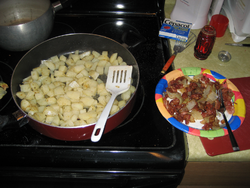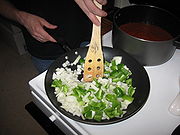
Sautéing
Encyclopedia

Cooking
Cooking is the process of preparing food by use of heat. Cooking techniques and ingredients vary widely across the world, reflecting unique environmental, economic, and cultural traditions. Cooks themselves also vary widely in skill and training...
food
Food
Food is any substance consumed to provide nutritional support for the body. It is usually of plant or animal origin, and contains essential nutrients, such as carbohydrates, fats, proteins, vitamins, or minerals...
, that uses a small amount of fat
Fat
Fats consist of a wide group of compounds that are generally soluble in organic solvents and generally insoluble in water. Chemically, fats are triglycerides, triesters of glycerol and any of several fatty acids. Fats may be either solid or liquid at room temperature, depending on their structure...
in a shallow pan
Cookware and bakeware
Cookware and bakeware are types of food preparation containers commonly found in the kitchen. Cookware comprises cooking vessels, such as saucepans and frying pans, intended for use on a stove or range cooktop. Bakeware comprises cooking vessels intended for use inside an oven...
over relatively high heat. Ingredients are usually cut into pieces or thinly sliced to facilitate fast cooking. The primary mode of heat transfer during sautéing is conduction between the pan and the food being cooked.
Food that is sautéed is browned while preserving its texture
Mouthfeel
Mouthfeel is a product's physical and chemical interaction in the mouth, an aspect of food rheology. It is a concept used in many areas related to the testing and evaluating of foodstuffs, such as wine-tasting and rheology. It is evaluated from initial perception on the palate, to first bite,...
, moisture
Moisture
Humidity is the amount of moisture the air can hold before it rains. Moisture refers to the presence of a liquid, especially water, often in trace amounts...
and flavor
Flavor
Flavor or flavour is the sensory impression of a food or other substance, and is determined mainly by the chemical senses of taste and smell. The "trigeminal senses", which detect chemical irritants in the mouth and throat as well as temperature and texture, are also very important to the overall...
. If meat, chicken, or fish is sautéed, the sauté is often finished by deglazing
Deglazing (cooking)
Deglazing is a cooking technique for removing and dissolving caramelized bits of food from a pan to make a pan sauce.When a piece of meat is roasted, pan fried or prepared in a pan with another form of dry heat, a deposit of caramelized sugars, carbohydrates, and/or proteins forms on the bottom of...
the pan's residue to make a sauce.
Sautéing is often confused with pan-frying, in which larger pieces of food (for example, chops or steaks) are cooked quickly, and flipped onto both sides. Some cooks make a distinction between the two based on the depth of the oil used, while others use the terms interchangeably. Sautéing differs from searing
Searing
Searing is a technique used in grilling, baking, braising, roasting, sautéing, etc., in which the surface of the food is cooked at high temperature so a caramelized crust forms. Similar techniques, browning and blackening, are typically used to sear all sides of a particular piece of meat, fish,...
in that searing only browns the surface of the food. Olive oil
Olive oil
Olive oil is an oil obtained from the olive , a traditional tree crop of the Mediterranean Basin. It is commonly used in cooking, cosmetics, pharmaceuticals, and soaps and as a fuel for traditional oil lamps...
or clarified butter
Clarified butter
Clarified butter is milk fat rendered from butter to separate the milk solids and water from the butterfat. Typically, it is produced by melting butter and allowing the different components to separate by density...
are commonly used for sautéing, but most fats will do. Regular butter
Butter
Butter is a dairy product made by churning fresh or fermented cream or milk. It is generally used as a spread and a condiment, as well as in cooking applications, such as baking, sauce making, and pan frying...
will produce more flavor but will burn at a lower temperature
Temperature
Temperature is a physical property of matter that quantitatively expresses the common notions of hot and cold. Objects of low temperature are cold, while various degrees of higher temperatures are referred to as warm or hot...
and more quickly than other fats due to the presence of milk
Milk
Milk is a white liquid produced by the mammary glands of mammals. It is the primary source of nutrition for young mammals before they are able to digest other types of food. Early-lactation milk contains colostrum, which carries the mother's antibodies to the baby and can reduce the risk of many...
solids, so clarified butter
Clarified butter
Clarified butter is milk fat rendered from butter to separate the milk solids and water from the butterfat. Typically, it is produced by melting butter and allowing the different components to separate by density...
is more fit for this use.
Etymology
The French word sauté is a past participle of "to jump". This refers to the need to have pan and fat, or oil, to about 250°C (500°F) or higher. Whole butter and many oils will not withstand this amount of heat without reaching their "smoking point" meaning the temperature that they begin to burn. When ingredients are added to this amount of heat they hop and "jump" around in the pan confirming that you have begun with a sufficient amount of heat. Always heat your pan and fat or oil first before adding the ingredients. True Sauté can be performed without even moving the pan at all. Movement of a pan is referred to as "flipping the pan" and is not required in true Sauté. "Flipping a pan" or movement is just a professional term for ingredient agitation without the use of utensils.Performing a sauté


A sauté pan must be large enough to hold all of the food in one layer, so steam can escape - which keeps the ingredients from stewing, and promotes the development of fond. Most pans sold specifically as sauté pans have a wide flat base and low sides, to maximize the surface area available for heating. The low sides allow quick evaporation and escape of steam. While skillets typically have flared or rounded sides, sauté pans sold for home use also typically have straight, vertical sides - this keeps the ingredients from escaping as the pan is jerked or stirred.
Only enough fat to lightly coat the bottom of the pan is needed for sautéing; too much fat will cause the food to fry rather than just to slide, and may interfere with the development of fond. The food is spread across the hot fat in the pan, and left to brown, turning or tossing frequently for even cooking.
The sauté technique involves gripping the handle of the sauté pan firmly, and using a sharp elbow motion to rapidly jerk the pan back toward the cook, repeating as necessary to ensure the ingredients have been thoroughly jumped. Tossing or stirring the items in the pan by shaking the pan too often, however, can cause the pan to cool faster and make the sauté take longer.
See also
- CookingCookingCooking is the process of preparing food by use of heat. Cooking techniques and ingredients vary widely across the world, reflecting unique environmental, economic, and cultural traditions. Cooks themselves also vary widely in skill and training...
- Cookware
- Stir fryingStir fryingStir frying is an umbrella term used to describe two Chinese cooking techniques for preparing food in a wok: chǎo and bào . The term stir-fry was introduced into the English language by Buwei Yang Chao, in her book How to Cook and Eat in Chinese, to describe the chǎo technique...
(Asian cuisine) - Sweating (cooking)Sweating (cooking)Sweating in cooking is the gentle heating of coarsely cut vegetables in a little oil or butter, with frequent stirring and turning to ensure that any emitted liquid will evaporate. Sweating usually results in tender, sometimes translucent, pieces. Sweating is often a preliminary to further cooking...

